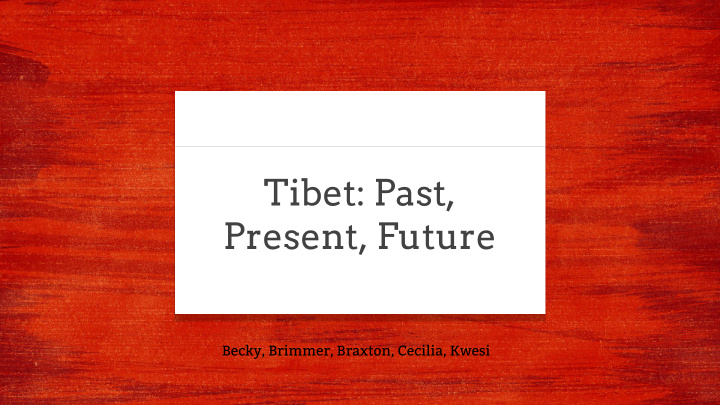



Tibet: Past, Present, Future Becky, Brimmer, Braxton, Cecilia, Kwesi
History Pre 1950 Suzerainty East India Tea Company and Tibet ■ Priest-patron relationship ■ 13th Dalai Lama Claims independence in 1912 https://www.youtube.com/watch?v=ia6Tvpj6dPw 2
History and the Cultural Revolution 17 point agreement Fleeing of the Dalai Lama Mao Zedong and the People’s Liberation Army 3
Tibet in the 1980’s Dalai Lama’s 5 point peace plan Open Door Economy 1987 Riots 1989 international protests https://savetibet.org/my-personal-words-of-gra 4 titude/photo-1/
Current Violence Themes of Violence: Suppression of rights ■ Protests and Riots ■ Inequality ■ https://www.cnn.com/2012/01/31/world/asia/china-ti betans-explainer/index.html 5
Direct Violence Death and torture ■ Displacements ■ Environmental issues ■ Reproductive rights ■ 6
Structural Violence Suppression of rights ■ Destruction of culture ■ Economic inequality ■ http://www.tibetnature.net/en/suffering-tibetan -nomads/ 7
Vision for the Future ■ Total self-determination Complete ethnic ■ region ■ Accepted into the international community Peaceful relations ■ with China 8
Vision for the Future Reconstruction ■ Right to return ■ Stable economy ■ Education ■ Environment ■ 9
Strategy for Peace Stage One: Breaking China’s Hold ■ Human Rights ■ Sanctions International Law ■ NGOs and IGOs ■ ■ Peace/ Nonviolence movements ■ Track Two Diplomacy Religion ■ Self-Determination ■ 10
Strategy For Peace Stage Two: Re-Building Tibet ■ Human Rights Peace/Non-violent movements ■ Religion ■ Diplomacy ■ ■ Self-determination IGOs and NGOs ■ Sustainable ■ economic development 11
Stage One: Stage Two: Stage Three: Breaking China’s Hold Re-Building Tibet A Peaceful Tibet Human rights violations 1. An autonomous Peace movements Tibetan government continue using human International sanctions 2. Stable economy rights and religious and enforcement of law 3. Equal educational freedoms as platform opportunities IGOs and NGOs provide 4. Good environmental Diplomatic efforts solidify support conditions Tibet as fully Peace movements occur 5. More freedom self-determined using non-violent tactics 6. Apart of the International IGOs and NGOs aid Tibet Track II diplomacy using Community by fostering sustainable religious leaders leads to 7. Peaceful Relations economic development semi self-determination with China 12
Recommend
More recommend